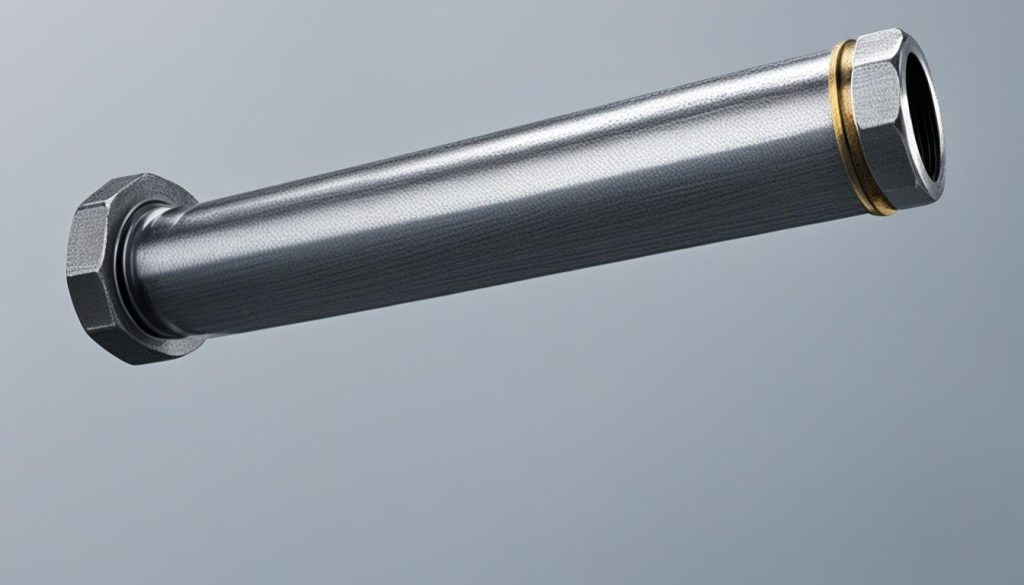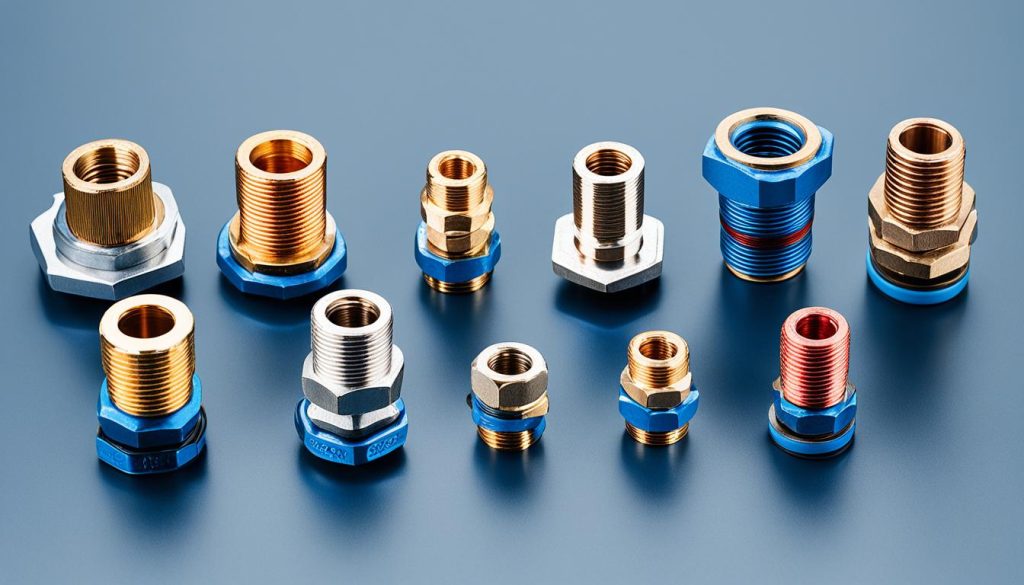FPT Meaning in Plumbing – Your Quick Guide
Did you know that understanding FPT, or Female Pipe Thread, is crucial for creating secure and leak-free plumbing connections? As a widely used type of pipe thread, FPT plays a vital role in ensuring the integrity and functionality of plumbing fittings and fixtures. To help you gain a better understanding of this essential component, let’s explore what FPT means in plumbing and how it relates to the broader context of pipe threading.
Key Takeaways:
- FPT, or Female Pipe Thread, is a type of pipe thread used in plumbing connections.
- It is interchangeable with NPT (National Pipe Thread), a widely used standard for tapered pipe threads in the United States.
- FPT connections create secure and leak-free seals in plumbing fittings and fixtures.
- Understanding FPT and its characteristics helps in selecting the right fittings and ensuring proper assembly.
- Proper thread engagement and the use of thread sealants are important for reliable and durable plumbing connections.
The History of NPT Pipe Threading
NPT pipe threading has a fascinating history that can be traced back to the 19th century in the United States. It was developed as a solution to the prevalent issues of inconsistent and leak-prone pipe threads during that time. The NPT standard emerged as a reliable method of joining pipes and fittings, offering a secure and tight seal.
The acronym NPT stands for National Pipe Thread (tapered), and it has become the primary threading standard used in the plumbing industry. By implementing NPT pipe threading, plumbers and professionals can ensure durable and leak-free connections. This standard has played a vital role in the advancement of plumbing systems, providing a secure and reliable method of connecting pipes and fittings.
It’s worth noting that NPT is not the only pipe thread acronym used in the industry. Other commonly used acronyms include FIP (Female Iron Pipe) and MIP (Male Iron Pipe), which are interchangeable with NPT. These acronyms represent the different genders of pipe threads, allowing for seamless connections between fittings and fixtures.
To understand the significance of NPT pipe threading, it’s crucial to acknowledge its rich history and the role it has played in revolutionizing plumbing connections. Now, let’s delve deeper into the characteristics and design of NPT threads.
NPT Pipe Thread Acronyms
| Acronym | Meaning |
|---|---|
| NPT | National Pipe Thread (tapered) |
| FIP | Female Iron Pipe |
| MIP | Male Iron Pipe |
Characteristics and Design of NPT Threads
NPT threads, or National Pipe Threads, possess distinct characteristics that contribute to their functionality and effectiveness in plumbing applications. Understanding these characteristics is essential for selecting the appropriate fittings and ensuring secure connections within a plumbing system.
One crucial characteristic of NPT threads is their tapered design. As the threads approach the end of the pipe or fitting, they gradually narrow. This taper plays a significant role in creating a secure and tight seal when the threads are engaged. The gradual reduction in width enhances the sealing capability, preventing leaks and maintaining the integrity of the connection.
Another important feature of NPT threads is their thread angle. NPT threads have a thread angle of 60 degrees, which promotes a strong and stable connection. The angle facilitates an interference fit at the point of contact between the threads, ensuring a reliable seal and preventing any potential leaks.
It is crucial to exercise caution when tightening NPT connections. Overtightening can lead to damage to the threads, compromising the seal and resulting in leaks. Proper thread engagement, without excessive force, is key to maintaining the integrity of the connection and preventing any issues.
The following table provides a visual representation of the characteristics of NPT threads:
| Tapered Threads | Thread Angle |
|---|---|
 |
60 degrees |
Variations of NPT Threads
When it comes to NPT threads, there are a few variations that have specific designations. Let’s take a closer look at these variations and their respective characteristics:
NPT
NPT, or National Pipe Taper, is the standard tapered thread used for general-purpose pipe connections in the United States. It is widely accepted and commonly used in plumbing applications.
NPTF
NPTF, or National Pipe Taper Fuel, threads have a modified crest and flank design compared to standard NPT threads. This modification provides enhanced sealing capabilities, making NPTF threads suitable for use in hydraulic and pneumatic systems. They are commonly found in applications where a leak-tight seal is critical.
NPS
NPS, or National Pipe Straight, threads are different from NPT threads as they are straight and do not have a taper. They are typically used in applications where a tight seal is not required, such as in certain mechanical and structural systems.
Compatibility with Other Thread Standards
It’s important to note that NPT threads are not compatible with other thread standards, such as BSP (British Standard Pipe) threads. BSP threads have different tapers and thread angles, making them incompatible with NPT threads. Therefore, it is crucial to ensure that the appropriate thread type is selected for a specific application to ensure proper fit and functionality.
| NPT Variation | Main Characteristics | Common Applications |
|---|---|---|
| NPT | Tapered threads | General-purpose plumbing connections |
| NPTF | Modified crest and flank design | Hydraulic and pneumatic systems |
| NPS | Straight threads | Mechanical and structural systems |
Applications of NPT Threads
NPT threads play a vital role in a wide range of industries and applications, including plumbing, hydraulics, and construction. Let’s explore the diverse uses of NPT threaded connections and their significance in these fields.
In Plumbing
In the plumbing industry, NPT threads are extensively utilized for connecting pipes, valves, and fittings in both residential and commercial settings. These threads provide a reliable and secure seal, ensuring leak-free plumbing systems. Whether it’s installing faucets, showerheads, or pipes, NPT threads are essential for creating robust and durable connections.
In Hydraulics and Pneumatics Systems
NPT threads are also highly valued in hydraulics and pneumatics systems due to their exceptional sealing capabilities and resistance to vibration and pressure. These threads enable the construction of reliable and leak-proof connections, ensuring optimal performance and safety in hydraulic and pneumatic machinery and equipment.
In Industrial Machinery and Equipment
NPT threads can be found in various types of industrial machinery and equipment where fluid and gas transport is essential. From pumps and compressors to valves and tanks, NPT threaded connections facilitate the efficient and secure flow of materials within these systems, contributing to their overall functionality and reliability.
In Construction
The construction industry extensively utilizes NPT threads for connecting pipes in heating, ventilation, and air conditioning (HVAC) systems. These connections ensure the smooth and reliable distribution of fluids within HVAC systems, allowing for effective temperature control and comfort in residential, commercial, and industrial buildings.
Overall, NPT threads serve as a reliable and versatile solution for various applications, providing secure and leak-free connections in plumbing, hydraulics, and construction. Their design and functionality make them indispensable in industries that require reliable fluid and gas transport, ensuring efficient operation and safety.
| Irreplaceable Applications of NPT Threads | Benefits |
|---|---|
| Plumbing | – Secure connections – Leak-free performance |
| Hydraulics and Pneumatics Systems | – Enhanced sealing capabilities – Resistance to vibration and pressure |
| Industrial Machinery and Equipment | – Efficient fluid and gas transport – Reliable performance in diverse applications |
| Construction | – HVAC system connectivity – Optimal temperature control in buildings |
Considerations and Challenges of NPT Threads
While working with NPT threads, it is essential to be aware of the various considerations and challenges that can arise. Here are some key aspects to keep in mind:
1. Thread Engagement
Proper thread engagement is vital to ensure a reliable and leak-free seal. It is crucial to ensure complete thread engagement during assembly, as insufficient engagement can result in potential leaks and compromised fittings. Careful attention to thread alignment and tightening is necessary to achieve optimal results.
2. Thread Sealant
To enhance the seal and prevent leaks, the use of thread sealants is common practice in NPT connections. Thread sealants, such as Teflon tape or pipe dope, create a barrier between the threads, increasing the sealing effectiveness. Applying the appropriate thread sealant can help maintain the integrity of the connection and ensure long-term reliability.
3. Tapered Thread Limitations
Tapered threads, like NPT, have limitations that need to be considered. Over time, repeated assembly and disassembly can cause wear and tear on the threads, potentially leading to diminished sealing capabilities. Proper care must be taken to avoid overtightening or damaging the threads during installation or removal.
4. Compatibility
It is essential to note that NPT threads are not compatible with other thread standards, such as BSP threads (British Standard Pipe). These threads have different tapers, thread angles, and dimensions, making them incompatible for direct connections. Therefore, it is crucial to ensure compatibility between the threaded components to avoid issues and leaks in the system.
To summarize, navigating the challenges of NPT threads requires attention to detail during thread engagement, the use of appropriate sealants, understanding the limitations of tapered threads, and ensuring compatibility with other thread standards. By considering these factors, one can overcome challenges and create secure and reliable connections in plumbing and other applications.
| Considerations and Challenges of NPT Threads |
|---|
| 1. Thread Engagement |
| 2. Thread Sealant |
| 3. Tapered Thread Limitations |
| 4. Compatibility |
The Importance of Understanding FPT in Plumbing
As a professional in the plumbing industry, I can’t stress enough the importance of understanding Female Pipe Thread (FPT) connections. FPT is a type of pipe thread that plays a crucial role in creating secure and leak-free connections in plumbing fittings and fixtures. By mastering the characteristics and variations of NPT threads, which FPT is interchangeable with, you’ll be equipped to select the right fittings and ensure proper assembly.
Having a deep understanding of FPT and its relationship to NPT threads allows you to create reliable and durable plumbing connections. This knowledge ensures that every connection you make is secure, preventing leaks and maintaining the overall integrity of the plumbing system. With FPT connections, you can have peace of mind knowing that your work is done with precision and expertise.
One of the reasons why FPT connections are widely used is their ability to provide a tight and lasting seal. By learning about the tapered threads and thread angle of NPT threads, you’ll gain insight into the mechanics of FPT connections and how they work to create a secure and leak-free seal. This understanding will guide you in choosing the right fittings and implementing them correctly, resulting in plumbing connections that stand the test of time.
In summary, understanding FPT in plumbing is crucial for creating secure fittings and preventing leaks. By familiarizing yourself with the characteristics and variations of NPT threads, you’ll be able to select the appropriate fittings, ensure proper assembly, and maintain the integrity of the overall plumbing system. Embrace this knowledge and elevate your expertise in the plumbing industry.
Source Links
- https://www.kegoutlet.com/what-is-mpt-fpt-what-is-npt.html
- https://www.angi.com/articles/what-is-fip-in-plumbing-abbreviations.htm
- https://www.spotix.com/blog/everything-about-pipe-thread-sizing
- Investing Wisely: How Windows & Doors in Boost Property Value and Financial Health - April 24, 2025
- The Financial Impact of Personal Injuries: Why Legal Help Matters for Business Owners - April 16, 2025
- The Hidden Financial Costs of Domestic Assault: What Business Owners Need to Know - April 16, 2025












